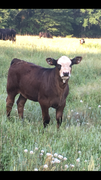Stocker Steve":2ddiowbl said:
sim.-ang.king":2ddiowbl said:
If you have been using bulls, and heifers out of your herd for the past 20ish years, then really you don't have breed X-Y-Z. After so long of genetic makeup coming from one source, you actually begin to stabilize the composite makeup, and make a new genetic line.
If you had 10 angus cows, and bred them all to a Simmental bull. Then took the resulting F1 calves, and only used them for breeding, say 1 bull and 6 heifers from the cross, and used the F1 bull on the F1 heifers. You would have a Line 1 composite, and after years of breeding within that line, you would make a stabilize composite line. Which would be neither Angus nor Simmental, but a composite.
Several folks here are selling sim angus bulls sired by the high growth AI bull of the month.
Seems like they cut about 1/2 to 2/3 of their Ai sired calves and sell the rest to producers with commercial cows.
The composite bulls picked look good, but are not very stable, and their often calves show it.
What percent of these composite bulls would you expect to sire consistently superor calves?
How much could this percentage improve with DNA testing?
Breeding one generation of a cross, would not be stable, and would take many generations within the one line to make stable. In a sense they become their own breed once they are stabilized. Then taking the calves from the composite line, and using those on any breed would make superior calves.
The calves from any bull, be it a cross, or PB, would have higher heterosis than the two parents, as long as the bull and cow don't share any breed. When they do share breeds completely there is no raise in heterosis, well maybe a microscopic amount, but you do get consistent calves. When you breed two crossbreds, and they share one or more breeds, you have less heterosis than when they have no shared breed. You also get a lot less consistent calf crops also.
So the best cross is usually either two different PB, or one F1 cross, and a PB of no relation.
Two F1's of no relations, would have high heterosis, but the calves would be very inconsistent.
As for your example of Cross bulls on cross cows, is that cross is to far crossed, you might say.
You would be better off using those crossbred bulls on PB cows of any kind, even if they share a breed.
But of course if you throw DNA testing in, you could in theory find a bull that is the least related to a cow, even within the same breed. Thus making a Outcross, which is a cross within a breed, from two parents that are related the smallest amount, and there would be heterosis.

